Features of removal depending on the type of paint and base
Before you start removing paint from the walls, you need to assess the situation:
- determine the type of paint and the base underneath it;
- decide how much time and money you are willing to spend;
- choose the appropriate paint removal option.
Types of paint
To determine the type of paint, start with a visual assessment. Enamel and oil paints have a glossy surface. Water-based paints are easily washed away with water. Acrylic does not shine and does not dissolve in water.
Water-based
Often used on ceilings and in dry rooms, removing such paint from the wall is easy:
- Pour warm water into a basin.
- Dip a roller or rag in water, wet the walls.
- Wait 15-20 minutes.
- Remove the coating with a spatula.
Tip: Before starting work, cover furniture and floors with film.
Instead of a roller or rag, it is convenient to use a pump sprayer – fill it with hot water and spray. It is also convenient to soak the wallpaper.

Acrylic
Unlike water-based paints, this one will have to be scraped off, working on a dry surface.
You can remove acrylic paint from the walls in a bathroom or other room using coarse-grained sandpaper – however, you will have to rub for a long time and you will need more than one sheet.
Another option is temperature. Using a building hair dryer, heat up the old paint and remove it like a film. A detailed method is described in the video.
Advice: If you plan to re-apply acrylic paint to the walls, you can leave the old coating on.
Oil
base, you will have to try. Solvent will help remove oil paint from small areas, but it has a strong odor and if the room does not have sufficient ventilation, it is better to refuse this option.
A proven temperature method for removing paint from a wall:
- Heat the area with a building hair dryer.
- Remove the paint with a spatula.
Important: When heated, caustic substances are released into the air, so you need to work in a respirator and in a well-ventilated apartment.
The safest, but longest method is mechanical. A hammer drill with a special attachment will help speed up the process, the process is described in the video:
To reduce the negative impact of vibration on the joints, wrap the attachment with a rag or foam rubber.
Base
The choice of the method for removing the old coating, as well as its speed and complexity, is influenced by the base.
Concrete
One of the most problematic combinations is an old layer of Soviet oil paint on a concrete wall. However, due to the porosity of the material, it is not easy to tear off any composition from it. The advantage is that you can use any method: mechanical, chemical or thermal.
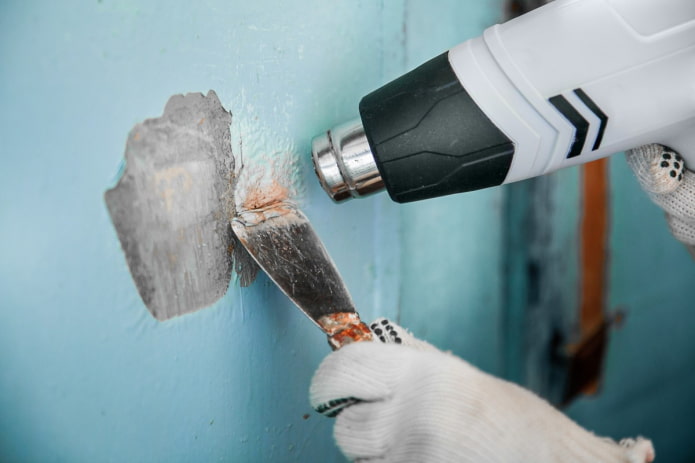
Plaster
Due to the ability of plaster to swell, it will be easy to remove paint from the walls above it. The simplest procedure:
- Make cuts on the surface.
- Apply warm water with a roller or sprayer.
- Leave it to act for 20-30 minutes.
- Remove the paint along with the plaster.

Brick
Any brick, be it sand-lime or ceramic, is defenseless against chemical compounds, so the use of a remover is discarded. You will not only spoil the appearance, but also destroy the masonry itself. Hard mechanical cleaning with sand or a hammer drill is also dangerous for brick.
The most reliable option in this case is sandpaper or a spatula. Or, in order to save time, you can order a soft blasting service from professionals:
Mechanical methods of removing paint
The safest in terms of the absence of toxic substances and unpleasant odor is the mechanical removal option. You will need an additional tool that can be either purchased or rented.
Important: Before any work, take care of your own safety. Put on a protective suit, glasses, a respirator and gloves!
With a spatula
The simplest and cheapest method is a spatula. With its help, you can remove paint from the walls even in the corners, around sockets and switches. The disadvantages include the complexity and duration of the work.
A spatula is often used in combination with thermal or chemical treatment. That is, the coating is initially heated or dissolved, and then scraped off.
Angle grinder
One of the fastest, but dangerous methods. If you do not have the skills to work with this tool, it is better to entrust the task to professionals or choose another method of removing paint.
A disadvantage is the large amount of dust and noise that the neighbors will not like.
Professionals advise using a diamond cup instead of a hard metal brush – thanks to its strength and high rotation speed, you can quickly and easily remove even a thick layer of paint.
Chisel
The main advantage of a hand chisel is its strength. If necessary, this tool can even withstand being tapped with a hammer without bending or deforming.
To remove paint from walls this way:
- Sharpen the chisel (this step needs to be repeated periodically).
- Place it at an angle of 60-80 degrees to the wall.
- Tap it, leaving gaps of 3-5 mm.
- Scrape off the remains with a chisel or spatula.
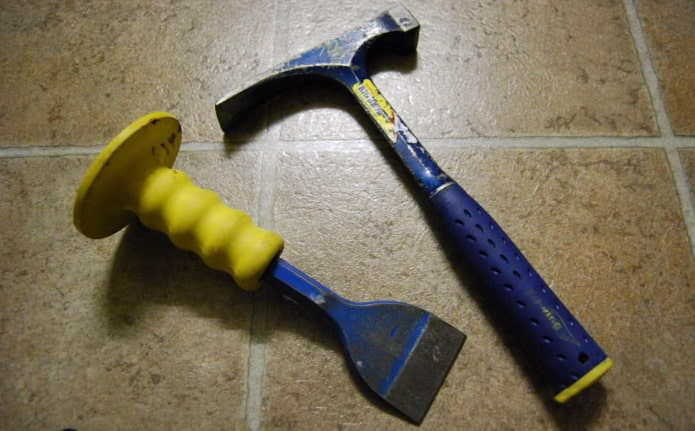
With an axe
For this method, choose a light and convenient tool, because a heavy axe you won’t be able to work all day.
The idea is the same notches as when working with a chisel. But here you will only need an axe.
Hold it at a right angle and strike the wall at a distance of 3-5 mm from each other.
Important: The paint will fly off, so protective glasses will come in handy.
With a drill with different attachments
Many craftsmen consider this method to be optimal, because almost every home has a drill, it is lighter than a hammer drill and safer than a grinder. At the same time, the process will be much faster than when working with a hand tool.
As with a grinder, an iron brush is not the most reliable option. It is much faster and easier to remove the composition from the wall using several fixed chains. Such an attachment is not difficult to make yourself, and its cost will be minimal. But you need to work with such a design at low speeds and away from furniture or plumbing.
In the video you will see the method in action:
Chemical paint removers
The easiest way to remove paint from a wall is with special compounds. You just need to apply them, wait and remove the coating. But this method has a negative effect on the respiratory tract, so if you are cleaning the walls in the bathroom, kitchen or toilet, take care of the ventilation.
Ready-made remover
Products are available in the form of gels, liquids, aerosols and powders. Depending on the composition, they can be acidic, alkaline and organic. There is a remover for each type, but there are also universal ones. For example: Fail-5, Antikras. Docker S4.
Important: When working with any chemicals, take precautions – wear a respirator, rubber gloves, properly dispose of the remains of the product.
The sequence of application is necessarily indicated on the packaging, but usually the steps are approximately the same:
- Clean the surface covered with paint from dust, if necessary, make notches for better penetration.
- Dilute the composition (when working with concentrates and powders).
- Apply to walls, floor or ceiling. For best results, cover with film.
- Wait a certain amount of time.
- Remove the coating with a spatula or chisel.
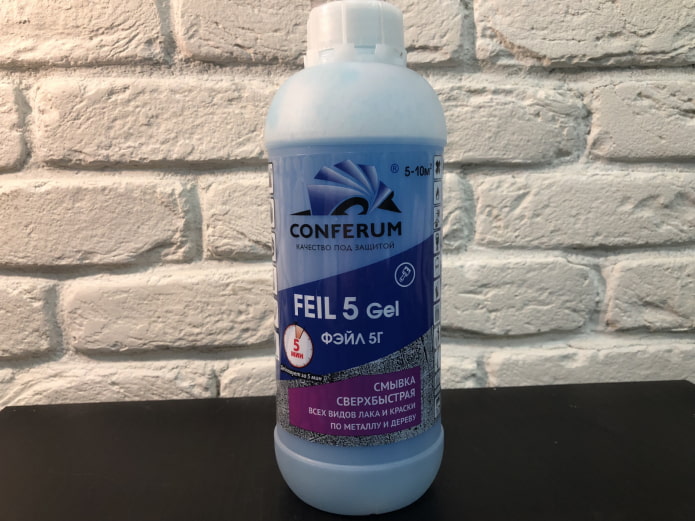
Homemade paint remover
You can make the remover yourself, here are a few recipes:
- 250 ml 10% ammonia, 1 l water, 2 kg chalk. Mix thoroughly, apply an even layer to the wall, wait 2 hours. Remove old paint.
- 100 g of soda ash, 300 g of quicklime, water. Dilute to the consistency of thick sour cream, apply for 12 hours, remove mechanically.
Homemade mixtures work on peeling or fresh coatings, it is better to remove strong or old ones mechanically or with a professional composition.
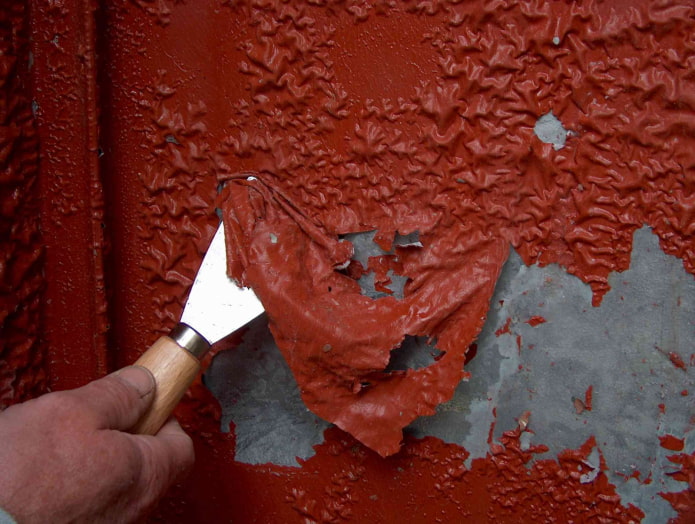
Thermal methods for cleaning a wall from old paint
Using high temperatures to remove paint and varnish coatings is an extreme measure. After all, this option is considered dangerous due to the possibility of ignition and the release of corrosive substances into the air.
Home iron
A simple option does not require professional tools, but will only be effective on low-quality coatings:
- Heat the iron to maximum.
- Tear off a sheet of thick foil.
- Heat the wall through the foil.
- Remove the material with a spatula or other sharp object.

Hair dryer
Technical Hair dryers can heat up to 500-600C, which allows you to melt a layer of paint on any surface, including wood. And the soft material can be easily removed with a spatula.
You can learn more about the method from the video:
Which method is the fastest?
The fastest mechanical option is to use a drill or grinder. It will probably be faster and easier to remove the enamel with a special remover, but you should take into account the harm of the composition itself and its high price.
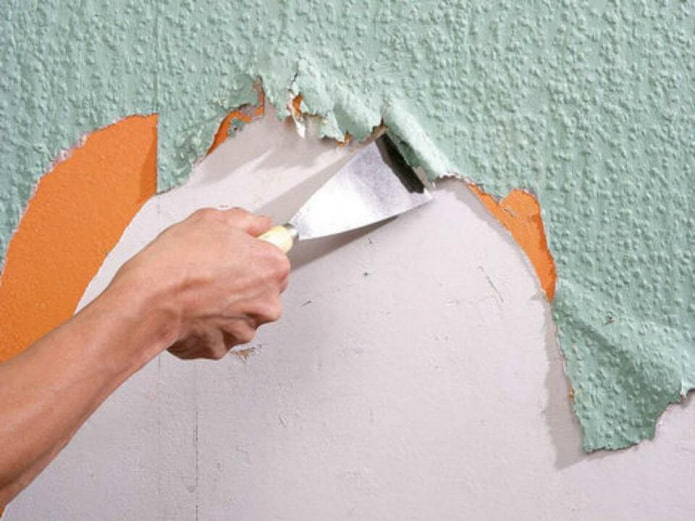
Always start the fight against old paint with an assessment of the composition, the coating underneath and your own capabilities.
Now reading:
- Ideas for a children’s room of 12 m²: design photos for girls and boys
- Types of ceiling plinths for stretch ceilings.
- Burgundy wallpaper in the interior: 55 examples for the living room, kitchen, bedroom and children’s room
- Bright kitchen: design ideas and 50 photos for interior inspiration.
- Experience the Luxury of the BMW 5 Series